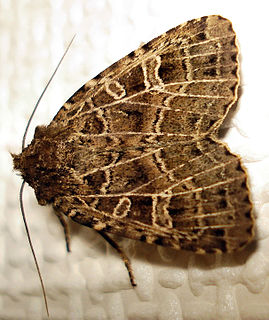The International Code of Zoological Nomenclature (ICZN) is a widely accepted convention in zoology that rules the formal scientific naming of organisms treated as animals. It is also informally known as the ICZN Code, for its publisher, the International Commission on Zoological Nomenclature. The rules principally regulate:

The Drepanidae is a family of moths with about 660 species described worldwide. They are generally divided in three subfamilies which share the same type of hearing organ. Thyatirinae, previously often placed in their own family, bear a superficial resemblance to Noctuidae. Many species in the Drepanid family have a distinctively hook-shaped apex to the forewing, leading to their common name of hook-tips.

The bordered white or pine looper, is a moth of the family Geometridae. Among these, it belongs to tribe Bupalini of the subfamily Ennominae. B. piniaria is a common species throughout the western Palearctic region, the Near East and North Africa. However, its presence in certain regions – e.g. the northern Balkans – is doubtful.

Nolidae is a family of moths with about 1,700 described species worldwide. They are mostly small with dull coloration, the main distinguishing feature being a silk cocoon with a vertical exit slit. The group is sometimes known as tuft moths, after the tufts of raised scales on the forewings of two subfamilies, Nolinae and Collomeninae. The larvae also tend to have muted colors and tufts of short hairs.

The Gothic is a moth of the family Noctuidae. The species was first described by Carl Linnaeus in his 1758 10th edition of Systema Naturae. It is distributed in temperate Eurasia, in the Palearctic realm, including Europe, Turkey, Iran, Caucasus, Armenia, Transcaucasia, Central Asia, Altai mountains, and west and central Siberia.

Eupterotidae is a family of insects in the order Lepidoptera with more than 300 described species.

Acronicta is a genus of noctuid moths containing about 150 species distributed mainly in the temperate Holarctic, with some in adjacent subtropical regions. The genus was erected by Carl Linnaeus in his 1758 10th edition of Systema Naturae. Caterpillars of most Acronicta species are unmistakable, with brightly colored hairy spikes, and often feed quite visibly on common foliate trees. The hairy spikes may contain poison, which cause itchy, painful, swollen rash in humans on contact. The larva of the smeared dagger moth is unusually hairy even for this genus. Acronicta species are generally known as dagger moths, as most have one or more black dagger-shaped markings on their forewing uppersides. But some species have a conspicuous dark ring marking instead.

The white-shouldered house moth is a species of gelechioid moth. It belongs to the subfamily Oecophorinae of the concealer moth family (Oecophoridae), just like the brown house moth. Though several presumed congeners of E. sarcitrella were described, its genus Endrosis is currently understood to be monotypic.

Are is a monotypic moth genus in the subfamily Arctiinae erected by Francis Walker in 1855. The type species is Are druryi, which is found on Jamaica. This species was described by Dru Drury in 1773 under the name Phalaena marginata, but this name is preoccupied by Phalaena marginataLinnaeus, 1758 and a new specific epithet, honouring Drury, was assigned in 1986.

Scythropia crataegella, the hawthorn moth, is a species of moth in the family Plutellidae from western Eurasia. It is usually placed in a small subfamily Scythropiinae, which is sometimes included in the Yponomeutinae of the Yponomeutidae.

Tinea pellionella, the case-bearing clothes moth, is a species of tineoid moth in the family Tineidae, the fungus moths. This species has a cosmopolitan distribution, occurring nearly worldwide.

Lygephila is a genus of moths in the family Erebidae. The genus was erected by Gustaf Johan Billberg in 1820.

Naenia is a genus of moths of the family Noctuidae erected by Stephens in 1827.

Tinea trinotella is a species of tineoid moth. It belongs to the fungus moth family (Tineidae), and therein to the nominate subfamily Tineinae. It was once used as type species of a distinct genus Acedes, but this is synonymized today with Tinea, the type genus of Tineinae, Tineidae and the superfamily Tineoidea.
Agapeta is a genus of moths belonging to the subfamily Tortricinae of the family Tortricidae.

Depressaria is a moth genus of the superfamily Gelechioidea. It is the type genus of subfamily Depressariinae, which is often – particularly in older treatments – considered a distinct family Depressariidae or included in the Elachistidae, but actually seems to belong in the Oecophoridae.

Tinea is a genus of the fungus moth family, Tineidae. Therein, it belongs to the subfamily Tineinae. As evident by its name, it is the type genus of its subfamily and family. Established as one of the first subgroups of "Phalaena", it used to contain many species of Tineidae that are nowadays placed in other genera, as well as a few moths nowadays placed elsewhere.
In the 10th edition of Systema Naturae, Carl Linnaeus classified the arthropods, including insects, arachnids and crustaceans, among his class "Insecta". Butterflies and moths were brought together under the name Lepidoptera. Linnaeus divided the group into three genera – Papilio, Sphinx and Phalaena. The first two, together with the seven subdivisions of the third, are now used as the basis for nine superfamily names: Papilionoidea, Sphingoidea, Bombycoidea, Noctuoidea, Geometroidea, Torticoidea, Pyraloidea, Tineoidea and Alucitoidea.

The parsnip moth or parsnip webworm is a moth of the family Depressariidae. It is found in most of Europe, except Portugal and most of the Balkan Peninsula.















